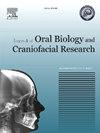Effect of fluoride toothpaste and mouthwash on the cytotoxicity of buccal mucosa cells in the presence of nickel-titanium archwires during comprehensive orthodontic treatment: A randomized clinical trial
Q1 Medicine
Journal of oral biology and craniofacial research
Pub Date : 2025-06-11
DOI:10.1016/j.jobcr.2025.06.007
引用次数: 0
Abstract
Objective
To evaluate the effect of fluoride on the cytotoxicity of buccal mucosa cells in the presence of nickel-titanium archwires.
Materials and methods
Seventy-five subjects requiring comprehensive orthodontic treatment were randomly allocated to three groups. Healthy control group included normal subjects who did not receive orthodontic treatment. In the treatment control group, only stainless-steel attachments were placed without archwire. Experimental group included subjects in whom stainless-steel attachments and 0.014″ nickel-titanium archwires were used. Fluoride mouthwash and toothpaste were prescribed to all subjects. Buccal mucosa cell smear was assessed for cell viability, micronucleus scores and caspase-3 reactive cells just before (T0) and 3-months (T1) after the intervention.
Results
The buccal mucosa cell viability score was significantly lower in the experimental and treatment control groups than in the healthy control group subjects (P < 0.001). Micronucleus score was significantly higher in the experimental and treatment control groups compared to the healthy control group subjects (P < 0.001). The caspase-3 reactive cells and micronucleus scores were significantly more in the experimental group subjects compared to treatment control group subjects (P < 0.001). There was a negative but statistically non-significant correlation between cell viability and micronucleus score among three groups of subjects.
Conclusion
The use of fluoride mouthwash and toothpaste in the presence of stainless-steel attachments and nickel-titanium archwire decreased the buccal cell viability by 8.51 % and increased the micronucleus score by 3.03 %. The use of fluoride toothpaste and mouthwash had a significant cytotoxicity effect on buccal mucosa cells in the presence of nickel-titanium archwire during comprehensive orthodontic treatment.
含氟牙膏和漱口水对综合正畸治疗中有镍钛弓丝存在的口腔黏膜细胞毒性的影响:一项随机临床试验
目的探讨氟对镍钛弓丝存在下口腔黏膜细胞毒性的影响。材料与方法将75例需要综合正畸治疗的受试者随机分为3组。健康对照组包括未接受正畸治疗的正常受试者。在治疗对照组中,仅放置不锈钢附着体,不放置弓丝。实验组采用不锈钢附着体和0.014″镍钛弓丝。给所有受试者开了含氟漱口水和牙膏。在干预前(T0)和干预后3个月(T1)评估口腔黏膜细胞涂片细胞活力、微核评分和caspase-3反应细胞。结果实验组和治疗对照组口腔黏膜细胞活力评分显著低于健康对照组(P <;0.001)。实验组和治疗对照组的微核评分均显著高于健康对照组(P <;0.001)。实验组患者的caspase-3活性细胞和微核评分明显高于治疗对照组(P <;0.001)。三组患者细胞活力与微核评分呈负相关,但无统计学意义。结论含氟漱口水和含氟牙膏在不锈钢附着体和镍钛弓丝存在的情况下,使口腔细胞活力降低8.51%,微核评分提高3.03%。在综合正畸治疗中,含氟牙膏和含氟漱口水对镍钛弓丝存在的口腔黏膜细胞有显著的细胞毒性作用。
本文章由计算机程序翻译,如有差异,请以英文原文为准。
求助全文
约1分钟内获得全文
求助全文
来源期刊

Journal of oral biology and craniofacial research
Medicine-Otorhinolaryngology
CiteScore
4.90
自引率
0.00%
发文量
133
审稿时长
167 days
期刊介绍:
Journal of Oral Biology and Craniofacial Research (JOBCR)is the official journal of the Craniofacial Research Foundation (CRF). The journal aims to provide a common platform for both clinical and translational research and to promote interdisciplinary sciences in craniofacial region. JOBCR publishes content that includes diseases, injuries and defects in the head, neck, face, jaws and the hard and soft tissues of the mouth and jaws and face region; diagnosis and medical management of diseases specific to the orofacial tissues and of oral manifestations of systemic diseases; studies on identifying populations at risk of oral disease or in need of specific care, and comparing regional, environmental, social, and access similarities and differences in dental care between populations; diseases of the mouth and related structures like salivary glands, temporomandibular joints, facial muscles and perioral skin; biomedical engineering, tissue engineering and stem cells. The journal publishes reviews, commentaries, peer-reviewed original research articles, short communication, and case reports.
 求助内容:
求助内容: 应助结果提醒方式:
应助结果提醒方式:


